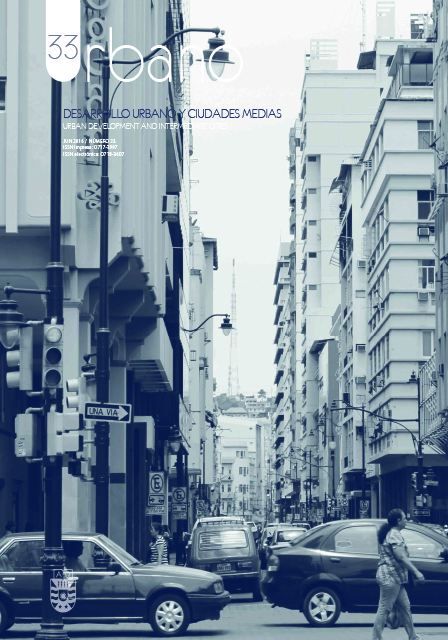Urban morphology and the thermal behavior of urban canyons: The development of a predictive model for maximum temperatures
Keywords:
urban morphology, thermal behavior, heat island, multivariate statistics, predictive modelAbstract
Cities modify the climatic parameters of the sites where they are located. One of the main changes is the increase in air temperature caused by urban heat islands (UHI). UHIs increase electricity demand and decrease the livability of indoor and outdoor spaces. This paper seeks to determine urban morphologies that help to reduce electric energy consumption and the UHI effect. To this end, 9 representative urban canyons (UC) in the metropolitan area of Mendoza, Argentina were selected, characterized and thermally monitored. With the indicators used to characterize the UCs, a predictive multivariate statistical model for maximum temperature was created (R2 = 0.85 and RSME = 2.41 %). This model was used to test 20 possible urban scenarios (16 forested and 4 non-forested UCs). As a result, it was observed that the maximum temperature in the forestedcases remains up to 12.7 ºC cooler than in the non-forested cases. Additionally, there is a difference of up to 9.8 ºC between the forested cases. This reveals the impact that the choice of urban combinations --forestation + morphology-- can have on thermal response when designing and planning city development schemes.
Downloads
References
ALCHAPAR, Noelia y CORREA, Erica. Comparison the performance of different facade materials for reducing building cooling needs. Eco-efficient materials for mitigating building cooling needs. Cambridge: Woodhead Publishing, pp.155-194, 2015.
AKBARI, Hashem, DAVIS, Susan, DORSANO, Sofia, HUANG, Joe, WINNETT, Steven. Cooling our Communities. US Environmental Protection Agency, Office of Policy Analysis, Climate Change Division, Washington, 1992.
CORREA, Erica, PATTINI, Andres, CÓRICA, Lorena, FORNÉS, M, LESINO, Graciela. Software: PIXEL DE CIELO, 2006. Número de registro CONICET: 07304.
CORREA, Erica, DE ROSA, Carlos y LESINO, Graciela. Urban heat island effect on heating and cooling degree day’s distribution in Mendoza’s metropolitan area. Environmental costs. En: EUROSUN (2008): 1st international conference on solar heating, cooling and buildings. Sociedade Portuguesa de Energia Solar, Lisboa, 2008, pp. 951-958.
CUADRAS, Carles. Nuevos métodos de análisis multivariante. Barcelona: CMC Editions, 2007.
Di RIENZO, Julio, CASANOVES, Fernando, BALZARINI, Mónica, GONZALEZ, L., TABLADA, M., ROBLEDO, C.W. InfoStat v. 2011. Grupo InfoStat, FCA, Universidad Nacional de Córdoba, Argentina, 2011.
EPRE, Ente Provincial de Regulación Eléctrica. Informe técnico de evolución de la demanda de enero de 2014 [en línea]. [Consultado10 Abril 2015]. Disponible en: http://www.epremendoza.gov.ar/
GIVONI, Baruch. Urban design in different climates. World meteorological organization, 1989.
IPV, Instituto Provincial de la Vivienda. Censo nacional de población, hogares y viviendas [en línea]. [Consultado 10 Abril 2015]. Disponible en: http://www.ipvmendoza.gov.ar/
INDEC, Instituto Nacional de Estadísticas y Censos. Censo nacional de población, hogares y viviendas [en línea]. [Consultado 10 Abril 2015]. Disponible en: http://www.censo2010.indec.gov.ar/
LIN, Tzu-Ping, MATZARAKIS, Andreas y HWANG, Ruey-Lung. Shading effect on long-term outdoor thermal comfort. Building and Environment, 2010, vol. 45, pp. 213-221.
MARSHALL, Stephen. Streets and Patterns. Londres y Nueva York: Spon Press, 2005.
McCARTHY, James; CANZIANI, Osvaldo; LEARY, Neil; DOKKEN, David; WHITE, Kasey. Intergovernmental Panel on Climate Change, Working Group II. Climate change 2001: impacts, adaptation, and vulnerability. Cambridge: Cambridge University Press, 2001.
McPHERSON, Gregorich. Cooling urban heat islands with sustainable landscapes. In: Platt, R.H. et al. (Eds.), The Ecological City: Preserving and Restoring Urban Biodiversity. University of Massachusetts Press, Amherst, MA, 1994, pp. 151-171.
ODUM, Howard y ODUM, Elisabeth. Energy basis for man on nature. Nueva York: 2nd edition McGraw Hill Higher Education,1980.
OKE, Timothy. The energetic basis of the urban heat island. Quarterly Journal Royal Meteorological Society, 1982, vol. 108, nº 45, pp. 1-24.
OKE, Timothy. IOM Report No. 81, WMO/TD No. 1250: Initial guidance to obtain representative meteorological observations at urban sites, 2004, WMO, Geneva.
RUIZ, María Angélica y CORREA, Erica. Suitability of different comfort indices for the prediction of thermal conditions in tree-covered outdoor spaces in arid cities. Theoretical and Applied Climatology, 2014, vol. 122, nº 1, pp. 69-83
SANTAMOURIS, Matheos, PAPANIKOLAOU, Nikos, LIVADA, I, KORONAKIS, I., GEORGAKIS, C., ARGIRIOU, A., y ASSIMAKOPOULOS, D. On the impact of urban climate on the energy consumption of buildings. Solar Energy, 2001, nº 70, pp. 201-216.
SALAMANCA, Francisco, GEORGESCU, Matei, MAHALOV, Alex, MOUSTAOUI, Mohamed y WANG, Lin. Anthropogenic heating of the urban environment due to air conditioning, Journal of Geophysical Research Atmospheres, 2014, vol. 119, nº 10, pp.1-17.
SHASHUA-BAR, Limor y HOFFMAN, Milo. Geometry and orientation aspects in passive cooling of canyon streets with trees. Energy and Buildings, 2003, nº 35, pp. 61-68.
STOCCO, Susana, CANTÓN, María Alicia y CORREA, Erica. Evaluación de las condiciones térmicas de verano y eficiencia ambiental de distintos diseños de plazas urbanas en Mendoza, Argentina. Hábitat Sustentable, 2013, vol. 3, nº 2, pp. 19-34.
WOLMAN, Abel. The metabolism of cities. Scientific American, 1965, pp. 156-174.
Downloads
Published
How to Cite
Issue
Section
License
The content of articles which are published in each edition of Habitat Sustentable, is the exclusive responsibility of the author(s) and does not necessarily represent the thinking or compromise the opinion of University of the Bio-Bio.
The author(s) conserve their copyright and guarantee to the journal, the right of first publication of their work. This will simultaneously be subject to the Creative Commons Recognition License CC BY-SA, which allows others to share-copy, transform or create new materials from this work for non-commercial purposes, as long as they recognize authorship and the first publication in this journal, and its new creations are under a license with the same terms.![]()























